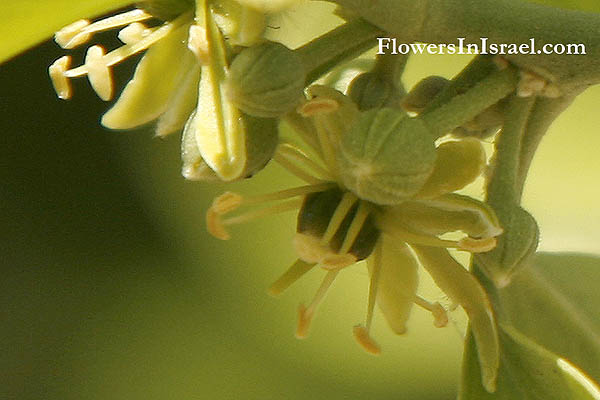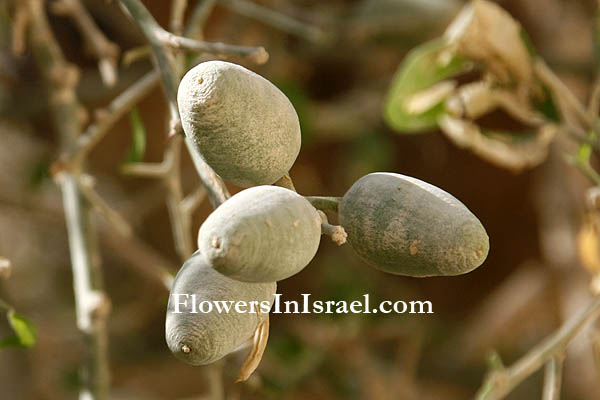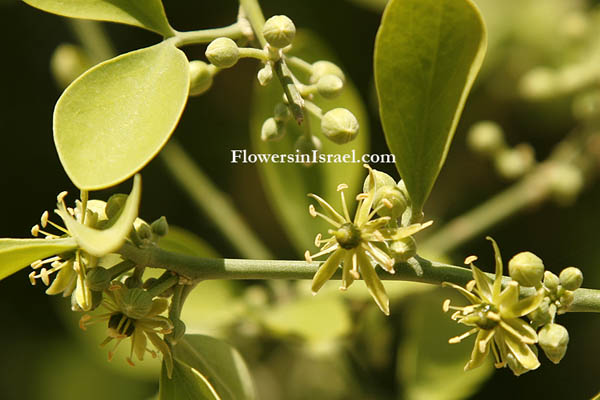|
|
| Life form: |
| Phanerophyte, tree |
| Spinescence: |
| Stems |
| Stems: |
| Multibranched, up to 10 m in height |
Leaves: |
| Alternate, simple leaves, two foliate, petioles are 3-6 mm long, leaflets are elliptic and have broadly pointed petioles up to 5 mm long |
| Flowers: |
| Bisexual, greenish white, fragrant, in axillary clusters, few or many in number, cymes or fascicles. 5 ovate sepals, 3 mm long; 5 oblong-obovate petals (longer than the sepals); 10 stamens, filaments glabrous, and anthers are dorsifixed; ovary ovoid, silky, 5-celled and ovules are solitary in each cell; style short,conical |
| Fruits / Pods: |
| Ovoid drupe, 2-5.6 cm long, brown or pale brown with a brittle coat enclosing a brown or brown-green sticky pulp and a hard stone seed |
Flowering Period: |
| February, March, April, May, June, July, August |
| Habitat: |
| Desert, thermophilous (heat-loving) |
| Distribution: |
| Mediterranean Woodlands and Shrublands, Semi-steppe shrublands, Deserts and extreme deserts |
| Chorotype: |
| Sudanian |
| Summer shedding: |
| Perennating |

Derivation of the botanical name:
Balanites,from a Greek word meaning "acorn-shaped".
aegyptiaca, "Egyptian".
The Hebrew name: זקום,Zaqqum from Arabic, Zaqqum, زقوم. In the Quran the tree is mentioned three times and is considered the bitter, stinky, bad tree among the trees, as trees are most frequently cited as gifts of a beneficent Creator, with the notable exception of the “tree of Hell”, the zaqqum. In the Islamic tradition, Zaqqum is regarded as the undercover tree that lives from the flames of fire and its bitter fruits serve as punishment for criminals in hell. According to the Quran, Zaqqum is a tree that "springs out of the bottom of Jahannam". The Quran states: "Here is a tree coming out in the heart of the underworld, its fruits are devil's heads" (Surat al-Safatat 64).
- The standard author abbreviation L. is used to indicate Carl Linnaeus (1707 – 1778), a Swedish botanist, physician, and zoologist, the father of modern taxonomy.
- The standard author abbreviation Delile is used to indicate Alire Raffeneau Delile (1778 – 1850), a French botanist.
- The standard author abbreviation Tiegh. is used to indicate Phillippe Édouard Léon van Tieghem (1839 – 1914), a French botanist.
Egypt was the centre of the production of a many great scents. In ancient times, the perfumes the most esteemed of all were those of the island of Delos, a Greek island in the Aegean Sea, and at a later period those of Mendes, a city located in the eastern Nile delta. The city was celebrated for the manufacture of a perfume designated as the Mendesium unguentum. (Plin. xiii. 1. s. 2.).
- Theophrastus (370 — ca.285 BCE), Dioscorides (ca. 40-ca. 90) and Pliny the Elder (23-79) provided us with a lot of information.
The base oil for some of the important scents was derived from the kernel of the Balanites aegyptiaca. The fruit looks like a date with a brittle shell, including a mass with a hard kernel. The oil derived from it is a slightly yellow.
Theophrastus (370 — about 285 BCE), [Enquiry into plants IV.II. 2-6]: "The balanos gets its name from its fruit; its leaf is like that of the myrtle but it is longer. The tree is of a good stoutness and stature, but not of a good shape, being crooked. The perfumers use the husks of the fruit, which they bruise; for this is fragrant, though the fruit itself is useless."
- Dioscorides (ca. 40-ca. 90)[The Greek Herbal of Dioscorides]: Oil of Balanites aegyptiaca.
"After the like manner is ye Oleum Balaninum prepared. It hath ye power of cleansing spots, lentiginum, down on the face, catricum nigritias, purging the belly also. But it is bad for ye stomach. It is good also for ye dolores avrium, & ye sonos, & for ye tinnitus, beeing poured in cum anserino adipe."
- Dioscorides and Pliny the Elder knew of the scent Mendesium, which in the first century CE was considered the most excellent and already then of ancient date.
"That which is called Mendesium, is made of Balanine oyle & Myrrhe, & Cassia, & Resina. Somme after they have cast in all other thinges by weight, doe moreover put in a little Cinnamon unprofitably. For the thinges which are not beaten together, doe not yield foorth their strength. It hath the like vertue with Metopium, yet in a lower degree."
Dioscorides provided us with another detailed prescription of a perfume whose main ingredient is lilies:
"Susinum (Lily perfume) is the most fluid of them all: it is made of lilies, oil of balanus, calamus (sweet flag), honey, cinnamon, saffron, and myrrh."
- Rabbi Shlomo ben Yitzchak (1040-1105), known as Rashi, author of influential Biblical and Talmudic commentaries, said that balm was the resin named as one of the ingredients of incense used in the tabernacle (Exodus 30:34). Balm was used in making perfume and was an ingredient in the holy oil used in the temple.
- Henry Baker Tristram [The Natural History of the Bible (1867)]: "The Balanites aegyptiaca, known to travellers as the False Balm of Gilead... The oil of the berry of the zukkum (so called by the Arabs) is carefully prepared by the Arabs of Jericho, and sold in large quantities to the pilgrims as balm of Gilead... But the most precious balm, that of Gilead, was probably the produce of the Balsamodendron gileadense, or Opobalsamum, which is now cultivated about Mecca."
- Excavations at Ein Gedi, Dead Sea, unearthed tools, pottery and furnaces of ancient workshops for the production of balm and perfume.
See the list of Medicinal herbs in Israel, the parts used and their medical uses to treat various diseases.
Bible resources:
- Genesis 37:25
As they sat down to eat their meal, they looked up and saw a caravan of Ishmaelites coming from Gilead. Their camels were loaded with spices, balm and myrrh, and they were on their way to take them down to Egypt.
- Genesis 43:11
Then their father Israel said to them, “If it must be, then do this: Put some of the best products of the land in your bags and take them down to the man as a gift—a little balm and a little honey, some spices and myrrh, some pistachio nuts and almonds.
- 2 Chronicles 28:15
The men designated by name took the prisoners, and from the plunder they clothed all who were naked. They provided them with clothes and sandals, food and drink, and healing balm. All those who were weak they put on donkeys. So they took them back to their fellow Israelites at Jericho, the City of Palms, and returned to Samaria.
- Jeremiah 8:22
Is there no balm in Gilead? Is there no physician there? Why then is there no healing for the wound of my people?
- Jeremiah 46:11
“Go up to Gilead and get balm, Virgin Daughter Egypt. But you try many medicines in vain; there is no healing for you.
- Jeremiah 51:8
Babylon will suddenly fall and be broken. Wail over her! Get balm for her pain; perhaps she can be healed.
- Ezekiel 27:17
“‘Judah and Israel traded with you; they exchanged wheat from Minnith and confections, honey, olive oil and balm for your wares.

|


